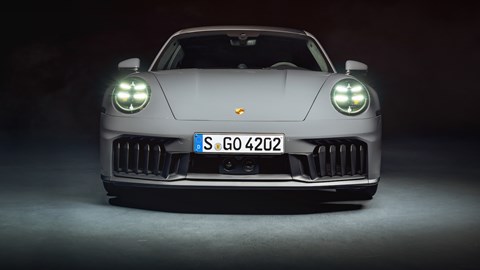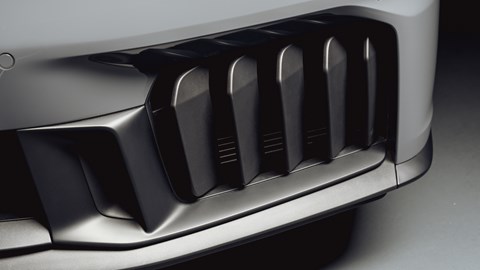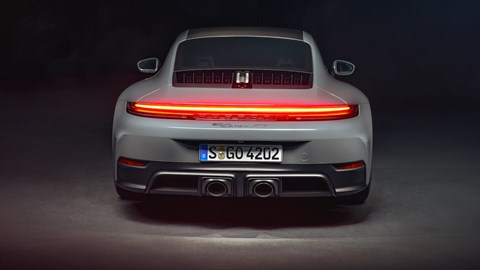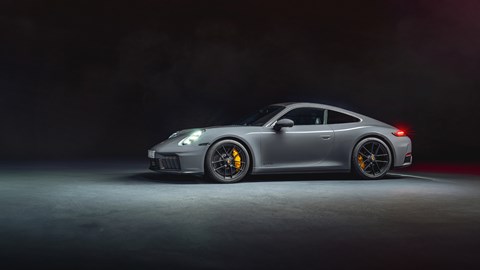► 911 gains two e-motors
► Weighs just 50kg more
► Carrera GTS starts at £132,600
Air to water, naturally-aspirated to turbo’d, and now hybrid. The Porsche 911 has been through plenty of iterations in its 61-year history and now there’s a further dramatic twist as the 911 embraces electrification.
Roll that around in your head – the 911 has gone hybrid.
It comes as part of the facelift for the 992 generation, dubbed 992.2: for the moment, the only updated models are the Carrera GTS (running the T-Hybrid system) and Carrera, the latter continuing with an updated version of the 3.0-litre twin turbo and no hybrid function. Crucially, this ‘base’ model starts at £99,800 so Porsche can still claim you can slide into a 911 for less than 100k (the GTS Coupe starts at £132,600 and is available as Targa, Cabriolet, two- or four-wheel drive).

A hybrid 911 sounds like a disaster…
This is not a hybrid as we know it (see below where we get a passenger ride). Instead, Porsche is aiming for maximum performance advantage, with minimal weight gain and zero efficiency benefit. There is no electric-only driving – that’s been possible in the past, noticeably in the 918 Spyder, but the 911 DNA and character is hallowed turf for Porsche. Mess with it at your peril.
So what we have is an all-new 3.6-litre engine running two electric motors – one in the turbo between the compressor and turbine wheels, and the other, more traditional permanent magnet unit, located at the rear end of the PDK gearbox.

The turbo is the clever one, although not completely unique as both Mercedes and Audi have run with similar set-ups. Here, it runs with an over-sized single turbo and provides up to 30bhp of assistance, spinning at up to 120,000rpm. Not a huge number of bhp, but it’s more how it provides power that transforms the GTS, giving up to 110lb ft of additional torque at low engine speeds. By providing an instant boost and negating any sort of turbo lag, it has transformed the car’s character – Porsche showed us various graphs that demonstrate how the Carrera GTS can reach peak acceleration seconds faster than a standard Carrera. In fact, it’s capable of out-stripping a Turbo S in the first 2.5 seconds from standstill.

There’s no longer a wastegate on the turbo. Instead, the electric motor does the same job, braking the system and transferring the recovered energy to the battery or second e-motor in the PDK ‘box depending on the use case.
How big is the battery?
The lithium-ion battery sits up front, behind the boot, and is only 1.9kWh. No electric running means you don’t need masses of cells and comes with the extra bonus of minimal additional weight (27kg). Porsche is claiming that, overall, the Carrera GTS is only 50kg heavier than the predecessor [i]in standard trim[i] but be careful with that caveat. As standard, the new car only comes with two seats. Compare like-for-like across the generations by inserting two rear seats (a no-cost option) and the weight gap jumps to about 75kg.

400V electrics power all this, with the result that you no longer need any external belt drive to power things like the starter motor or alternator. Indeed, the GTS no longer even has a starter motor, that job being done by the e-motor in the PDK and with a result of an instant ‘catch’. Much like a race car, it has minimal turnover, springing to life almost as soon as you thumb the new-for-992.2 starter button.
If it’s like a racer, does it have a manual?
Sadly not. There’s no manual in the Carrera GTS as it won’t work with the twin e-motor set-up. But one will still be available in the future when Porsche gets round to updating further models. My money would be on it being in the updated 911 T, given that the ‘old’ 3.0 litre twin turbo will continue to be sold and we know that it can run a manual. It’s another way of making the T distinct and cementing its halo status among non-GT 911s.
Rear-axle steering is now standard on the GTS (and hasn’t helped with the weight gain), while Porsche Dynamic Chassis Control is now electro-hydraulically controlled thanks to the high-voltage hybrid set-up. One further advantage of this is that the nose lift is much quicker to activate.
Is the styling different?
In Porsche terms, yes. The 10 active aero vanes at the front are the biggest clue – these help reduce the drag coefficient from 0.32 to 0.27Cd and also give the car a much more dramatic, shark-gill style. It’s not the only element of active aerodynamics, as there’s a diffuser under both the bonnet and front wing that channels air depending on where it’s needed. The headlights are also new and run Porsche’s now trademark four-point graphic. In typical Porsche logic, there’s a two-fold reason for this. Aesthetic, but also practical: by ditching the front indicator from the bumper and housing it within the headlight, there’s more space for cooling.

Inside, the analogue rev counter has been dropped for a digital one, helpful for making Apple CarPlay much more integrated but a pity for the purists.
There are now thinner rear lights, a new air inlet at the rear and a centre, twin-pipe exhaust. The rear tyres are also bigger on the GTS, measuring 315 across instead of 305. Helpful when it comes to putting down the extra low-down oomph of the GTS.

Looking at all this and being contrary, you do wonder why they bothered: they had a perfectly acceptable bi-turbo engine that had more life in it. Indeed, it carries on in the Carrera.
And yet they’ve still built an entire new powertrain at great cost that delivers negligible fuel savings; in today’s climate-skewed world, it seems like a miss. Not according to Michael Roesler, director model car line 911: ‘If you want to do a big step, hybrid technology is a good step for that. We wanted to make the 911 future-proof for any upcoming regulations. With the ICE, I think we’ve reached a really high level where I do not expect those big steps we made with the hybrid design.’

It’s clear, then, that there’s more to come from this technology – the GTS is merely the first rung.
Not that it’s without risk. I’ve got two pals who have both bought a 992.1 car on the basis that they were worried about the facelifted car getting flabby and electrified. They feared the loss of edge and for the very soul of the car. Judging by the theory and reality we saw in the GTS, both of those guys went too early. The 911 is in rude health.

Hitching a lift in the 992.2 911…
Stepping from a passenger ride in a Carrera 4 GTS, all I could do was puff my cheeks out and emit a ‘foof’ of air. Blame the potency of the 992.2 and the long limbs of Jörg Bergmeister, the man doing the passenger laps at Weissach. Class winner at Le Mans and 911 racer since the Big Bang, he’s not unafraid to push even this prototype car but even so. The levels of speed, grip and engine response meant I was grasping for intelligent ways of describing the experience but my scrambled brain could only mumble expletives.
It’s not the engine’s responsiveness that first grabs you. That comes later. What needs an immediate recalibration is the speed it can carry through corners, reacting with an agility that belies the size of the latest 911. It’s no longer a small car, after all.

Weirdly, I didn’t find myself using my feet to brace against the bulkhead as the car didn’t have much lateral rotation. Sure, it rolls but not to the point of being uncomfortable – instead, it gives the impression of zero lag in its movements and changes direction faster than any road car should. Especially given the fact it’s on worn Pirelli P Zero road tyres.
Noticing the engine comes later, once your brain has learnt to ignore the speeds. Reactions feel fast. Not quite at EV levels but certainly up there with the fastest ICE engines I’ve ever sat in. The 911 Turbo S is more brutal but the finesse on this Carrera GTS’s powertrain is what marks it out. Less sledgehammer, more scalpel.
It poses an interesting question. I thought the hybrid GTS would threaten the Turbo 911s, on account of its acceleration. But having ridden in one, I think it’s more a question of concern for the GT department because this 992.2, in GTS trim, is so reactive. The hybrid has created a rawer car than you’d imagine.
Check out our Porsche reviews